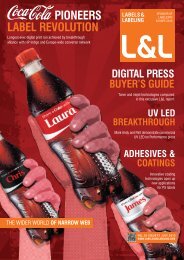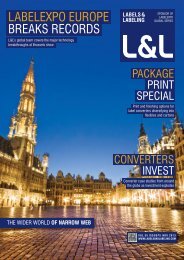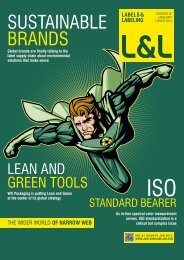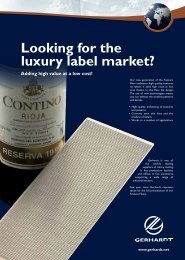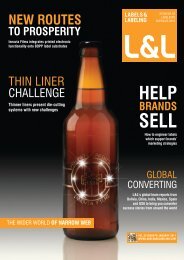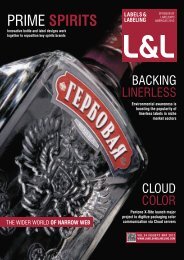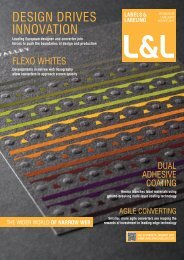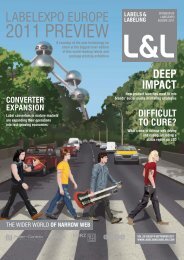THE DATA FRONT
Download as PDF - Labels & Labeling
Download as PDF - Labels & Labeling
- No tags were found...
You also want an ePaper? Increase the reach of your titles
YUMPU automatically turns print PDFs into web optimized ePapers that Google loves.
label Exposure |31<br />
1<br />
labelexposure<br />
3<br />
2<br />
How to<br />
get exposed<br />
Label Exposure is a new, regular<br />
section in Labels & Labeling.<br />
Submissions do not have to be a<br />
part of an awards competition – we<br />
are interested in any label which<br />
you feel deserves exposure. If you<br />
want to contribute, please send us<br />
information about who printed the<br />
label, for whom it was printed, and<br />
the specifications of the job. It is<br />
essential to include a good quality,<br />
high resolution image with your<br />
submission.<br />
Contact:<br />
jquirk@labelsandlabeling.com.<br />
2<br />
1 Chadwicks UK-based packaging company<br />
Chadwicks has launched a recyclable shrink sleeve<br />
specially designed for pots. Assuming the role of both<br />
label and cardboard sleeve, the new product has the<br />
potential to reduce packaging weight by up to 70 percent,<br />
costs by 30 percent and CO2 emissions due to reduced<br />
transport weight, according to the company.<br />
With the majority of food manufacturers that are using<br />
cups still employing conventional cardboard sleeves,<br />
labeling or direct printing, this alternative packaging<br />
application will bring the UK in line with the rest of Europe,<br />
where the technique is widespread.<br />
Particularly practical for multipack or duo products, the<br />
pots are stacked lid-to-lid and the shrink sleeve is applied<br />
to the product using a hot melt adhesive. Individual pots<br />
can then be separated via a specially designed horizontal<br />
perforation where the pots meet, which then allows the<br />
sleeve to remain intact on the individual pots for both<br />
aesthetic and brand-endorsement purposes.<br />
Once the consumer has finished with the product,<br />
the whole sleeve can then be removed via a vertical<br />
perforation along the length of the pots for ease of<br />
recycling.<br />
2. Baker label London, UK-based Baker Self<br />
Adhesive Label has won the ‘Adding Value’ award in a<br />
competition run by Digital Printer magazine that recognize<br />
achievements in digital printing technology.<br />
The company scooped the award with the Moo.com<br />
sticker for customized books. The stickers are produced<br />
on one of two 7-color HP Indigo ws4500 and ws4050<br />
digital presses in 3500 runs on a white gloss PVC<br />
substrate and are then laminated with polypropylene for<br />
durability.<br />
Managing director Steve Baker said: ‘Moo.com uses<br />
innovative web to print technology and sends us the<br />
variable data from its on-line library, PrintFinity. The<br />
stickers are then printed and die cut and delivered to Moo.<br />
com for subsequent conversion into personalized books<br />
for its customers. We are delighted to have received this<br />
award in the face of the strong growing competition in<br />
digital technology.’<br />
3. Ditone labels UK-based Ditone Labels has<br />
created innovative labels for the pumps used to inflate<br />
the Repose specialist hospital mattress overlay used<br />
for the prevention and treatment of pressure ulcers.<br />
Ditone created an innovative, technically designed label<br />
to work harmoniously with an applicator designed by<br />
Graham Machines, to replace an inefficient and prolonged<br />
production method. Ditone introduced the method of<br />
flexo application, which allows all the colors to be applied<br />
in one run at the point of assembly. The label has also<br />
helped increase consistency of brand and can easily be<br />
adapted to suit a range of markets.<br />
The labels are printed on clear polypropylene with a<br />
permanent adhesive, using two different colors. Using the<br />
color of the tube as a background, the adhesive involved<br />
creates an ‘invisible’ label. The labels also incorporate a<br />
white panel created using special writable varnish on to<br />
which hospital staff can write patient details This is applied<br />
in addition to an overall anti-scuff varnish to provide<br />
protection during handling and packaging.<br />
may 2009 | L&L



